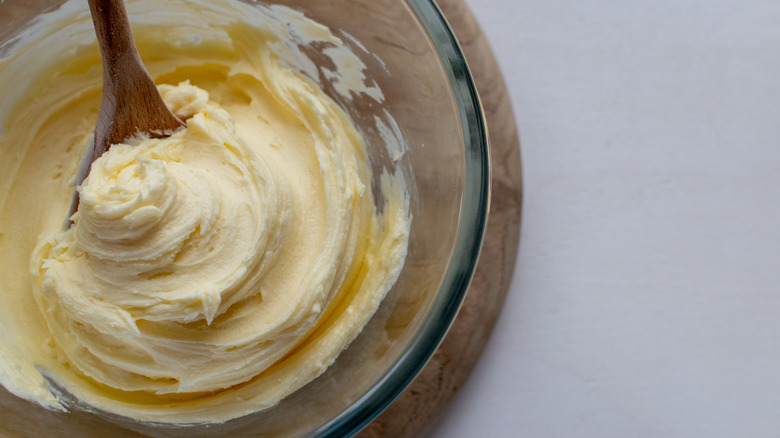The Butter Trick For Fixing Separated Buttercream
Picture this: You're baking a chocolate cake, a dozen vanilla cupcakes, or your favorite sheet brownies, and plan to finish off the baked good with a silky, creamy layer of frosting. You settle on making a smooth and delicious buttercream ... only to realize, once you've finished mixing, that your buttercream has separated. Instead of appearing smooth, cohesive, and creamy, your frosting looks lumpy, inconsistent, and entirely unappetizing. This baking disaster happens all too often, but while separated frosting may seem like a lost cause, this disappointment is actually reversible.
Unlike a burnt batch of cupcakes, a separated buttercream can be salvaged — and fixing your frosting is not as difficult as you may think. So, the next time you're making buttercream frosting, you may want to think twice before tossing a separated attempt into the garbage can. In fact, all you have to do to improve your buttercream is add some heat. Softening the butter just enough can overturn those dreaded lumps, and work wonders in counteracting a baking faux pas. There are a few ways you can pull off this trick, none of which require the ingredients to ever leave the bowl.
Soften buttercream with low heat to revive its texture
A little warmth goes a long way. Seriously, to revive a buttercream that's separated, simply warm the bowl's exterior little by little. You can take the easiest route and add some heat via your hands; wrapping your hands around a bowl of buttercream adds warmth that can, in turn, help the butter to soften. Positioning a warm towel around the bowl's base will also work. Of course, if you'd rather speed up this process, you can ultimately opt to use a hairdryer to heat the butter at a quicker pace.
No matter which method you choose, make sure you're softening the butter rather than melting it. Buttercream can be finicky, and the temperature of the butter is the key to your frosting's success. This rule holds especially true at the start of any buttercream endeavor; you don't want the butter to be too cold or too hot. Otherwise, it may — surprise! — separate. But, as already established, you don't have to perfect its consistency or temperature straight from the get-go. If your buttercream has separated, you can always redeem it after the fact. It's a very forgiving frosting, and with a slight increase of heat, you'll always have a second chance at perfection.

